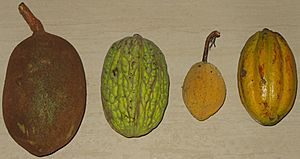Theobroma bicolor facts for kids
Quick facts for kids Theobroma bicolor |
|
|---|---|
 |
|
| Conservation status | |
| Scientific classification | |
| Genus: |
Theobroma
|
| Species: |
bicolor
|
| Synonyms | |
|
Theobroma ovatifolia Moc & Sessé ex DC. |
|
The Theobroma bicolor, often called the mocambo tree or jaguar tree, is a fascinating plant. It belongs to the same plant family, Malvaceae, as the well-known cocoa tree (Theobroma cacao). You can find this tree growing in Central America and South America. It thrives in parts of the Amazon rainforest in countries like Brazil, Colombia, Ecuador, and Peru.
Contents
About the Mocambo Tree
The mocambo tree was first described by famous scientists Alexander von Humboldt and Aimé Bonpland in 1808. They gave it its scientific name, Theobroma bicolor.
What the Tree Looks Like
The mocambo tree can grow quite tall. In open areas, it usually reaches about 3 to 8 meters (10 to 26 feet) high. But if it's growing in a dense forest, it can stretch up to 25 to 30 meters (82 to 98 feet) tall!
It's a slow-growing tree that prefers loose, soft soil. It can even survive in areas that get a little bit flooded. Sometimes, it can last through deeper floods too. In the central Amazon region, the tree produces its fruits from March to November. Its beautiful flowers bloom from July to September.
The Edible Parts of the Tree
Just like its cousin, the cocoa tree, the mocambo tree has edible seeds. These seeds are packed with energy and are rich in protein and fiber. They also contain healthy fats, like Omega 9, and a little bit of caffeine. The soft, sweet pulp around the seeds can also be eaten fresh.
How People Use the Mocambo Tree

Long ago, the Aztecs grew the mocambo tree alongside the cocoa tree. They used its seeds to make chocolate drinks. However, when the Spaniards arrived, they thought the chocolate made from mocambo seeds wasn't as good as that from cocoa.
Today, the seeds can be eaten in different ways. People sometimes fry them or add them to soups. After the seeds are removed, the empty fruit pods are often used as planters or containers.
Harvesting the Fruit
Harvesting mocambo fruit is quite easy! When the fruit is ripe, it naturally falls off the tree branches and lands on the ground. So, people simply collect the fallen fruits.
Special Foamy Drinks
The ancient Mayas loved drinks made from cacao and corn, especially the thick, buttery foam on top. Records from the time of the Conquista suggest that a stable, rich foam could be made using mocambo fruits. This was harder to achieve with just cocoa tree fruits.
Tree Health and Pests
Sometimes, plants can get sick, just like people. In 1999, a fungus called Moniliophthora perniciosa was found on a mocambo tree in Brazil. This fungus causes a plant disease known as "witch's broom disease." It's a problem that also affects cocoa trees.
See also
 In Spanish: Pataxte para niños
In Spanish: Pataxte para niños


